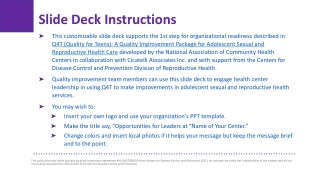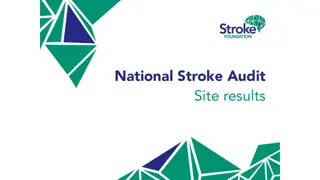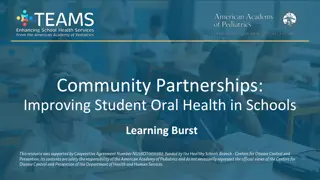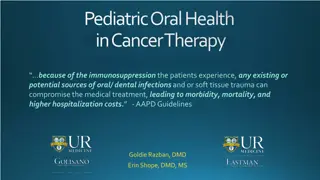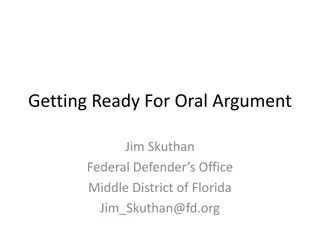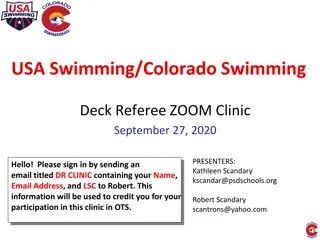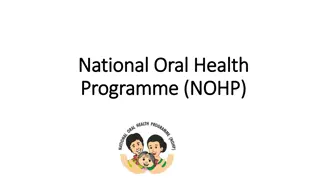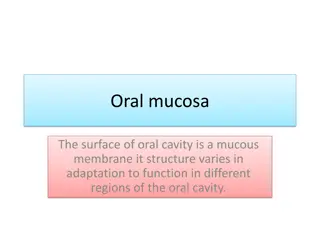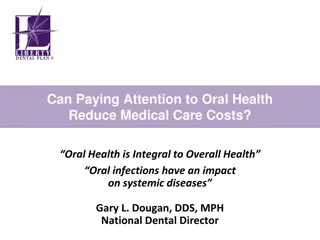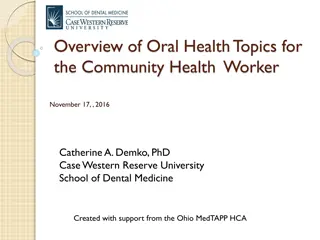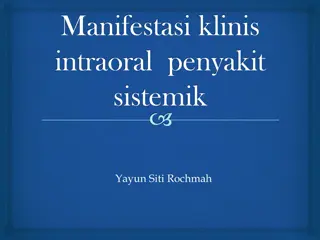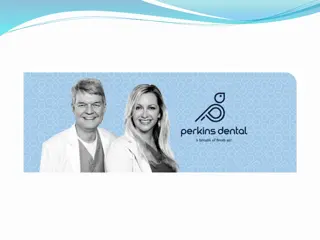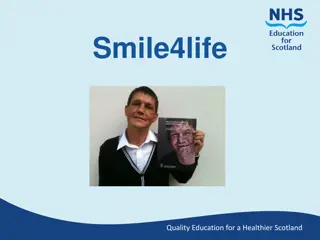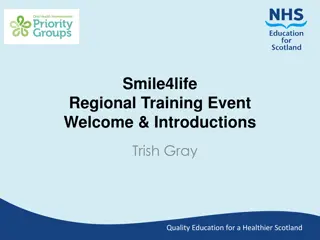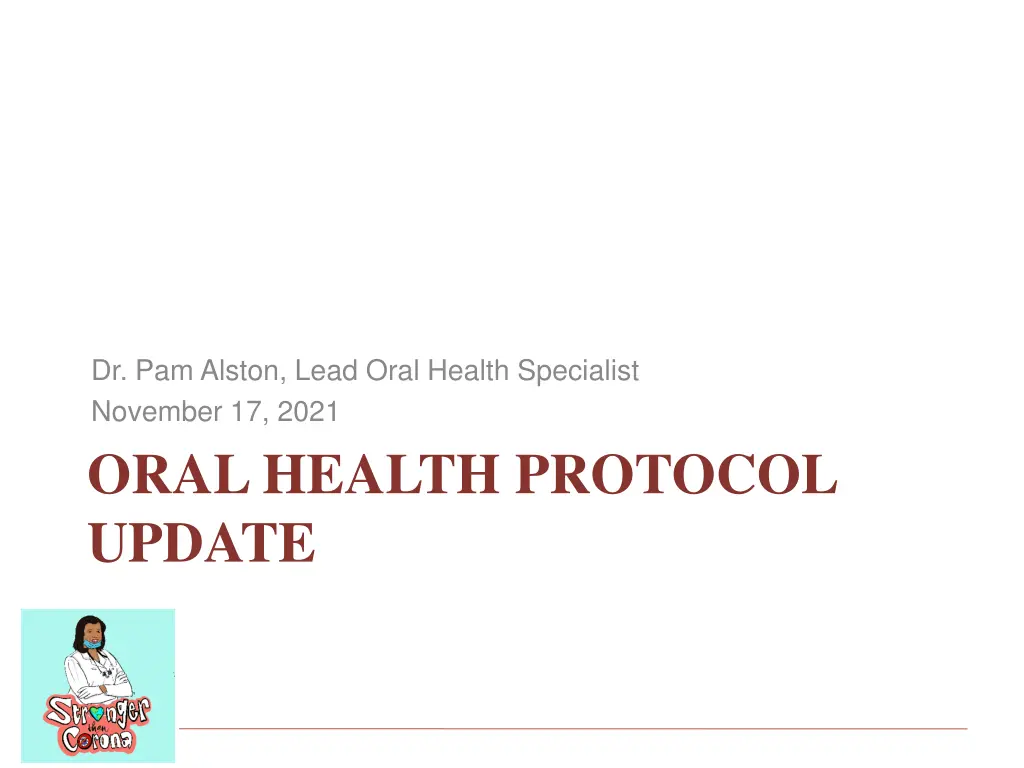
Oral Health Protocol Update and Job Corps Program Information
Stay updated on the latest oral health protocol and COVID-19 safety measures for Job Corps programs. Learn about the return of in-person enrollments, vaccination requirements, and wellness protocols to ensure a safe learning environment for students. Explore the guidelines for minimizing COVID-19 risks during oral health procedures and the importance of sterilization practices.
Download Presentation

Please find below an Image/Link to download the presentation.
The content on the website is provided AS IS for your information and personal use only. It may not be sold, licensed, or shared on other websites without obtaining consent from the author. If you encounter any issues during the download, it is possible that the publisher has removed the file from their server.
You are allowed to download the files provided on this website for personal or commercial use, subject to the condition that they are used lawfully. All files are the property of their respective owners.
The content on the website is provided AS IS for your information and personal use only. It may not be sold, licensed, or shared on other websites without obtaining consent from the author.
E N D
Presentation Transcript
Dr. Pam Alston, Lead Oral Health Specialist November 17, 2021 ORAL HEALTH PROTOCOL UPDATE
Webinar Objectives You will learn about Job Corps Safety directives You will review the Oral Health Protocol
Timeline to today Process in place to determine the centers ready to safely enroll new students for on- campus instruction Job Corps paused in-person enrollments and learning March 2020 On 10/15/21, Secretary of Labor announced resumption of traditional enrollment Virtual Enrollment process was developed as a stop-gap measure Job Corps leadership learned that on- center learning is the best JC students
Job Corps Program Information Notices (PIN) PIN 21-01 requires centers to determine students COVID-19 vaccination status and requires students to get vaccinated or follow enhanced testing, masking, and quarantine requirements. PIN 21-02 describes new testing, masking and quarantine requirements for fully vaccinated students, partially vaccinated students and unvaccinated students. PIN 21-03 outlines the protocol for returning nonresidential students to on-center learning. PIN 20-08 contains the Job Corps Center Resumption of Physical Center Operations Checklist for COVID-19 and was released September 2020.
COVID-19 Protocols for Wellness Provide guidance on how to minimize risk of a COVID-19 outbreak on a Job Corps Center during wellness care Interim guidance on how to address aspects of the students physical, emotional, behavioral, behavioral, and oral health needs during the pandemic.
Oral Health Protocol 4 Sections Centers for Disease Control and Prevention (CDC), Occupational Safety and Health Administration (OSHA). 1) Considerations and Logistics for Students Returning to Center Updated with information from the 2) Scope of oral health services with your center procedures and state and local guidelines and regulations following whichever regulations are the most restrictive. Take responsibility to stay up-to-date 3) Minimizing COVID-19 risk exposure during and post-aerosol generating oral health procedures protocol 4) Sterilization and Disinfection of Patient Care Items
Section 1: Considerations and Logistics for Students Returning to Center Written referral plan/agreement with an outside dental facility for emergency oral care on students with COVID-19 Perform preventive maintenance on dental equipment Test dental unit waterlines
Section 1: Considerations and Logistics for Students Returning to Center Perform routine cleaning Follow manufacturers recommendations on preventive maintenance Test the autoclave using a biological indicator Stock the dental facility Facilities management personnel will check the ventilation system Clean and disinfect all contact surfaces Only necessary equipment/supplies in operatories
Section 2: Scope of Oral Health Treatment Recognize the need to balance safety & care provision Screen students for COVID-19 symptoms Have hand sanitizer for use Enforce mask wearing for students except during intraoral care Do not treat COVID-19 positive or symptomatic students Defer care to students while they are in isolation or quarantine unless they have urgent or emergent needs
Section 3: Minimizing COVID-19 Risk Exposure During and Post-Aerosol Generating Oral Health Procedures (AGP) Protocol Oral cavity forms a continuum with the nasopharynx and lower respiratory tract AGP on patients with any type of infectious respiratory disease potential to create pathogen-rich aerosols AGP likely generate higher concentrations of infectious respiratory aerosols than coughing, sneezing, talking, or breathing Refer to PIN 20-02 for more information about aerosol containment equipment
Section 3: Minimizing COVID-19 Risk Exposure During and Post- Aerosol Generating Oral Health Procedures (AGP) Protocol Engineering Controls Dental hygienists should use hand instrumentation when possible Dentists should consider minimal restorative treatment when possible without performing a lower standard of care Incorporate HIPAA-compliant teledentistry Enforce social distancing in the waiting room and dental facility Close operatory doors during aerosol generating procedures Limit AGP to one patient at a time if there is less than 6 feet of space between unmasked students in adjacent treatment areas. Limit individuals in dental facility to student being treated and OHP
Section 3: Minimizing COVID-19 Risk Exposure During and Post- Aerosol Generating Oral Health Procedures Protocol Engineering Controls Engineering controls include rubber dams, high-volume evacuation, high-volume evacuators, and aerosol containment equipment AGP without a dental assistant at the chairside is below the standard of care
Section 3: Minimizing COVID-19 Risk Exposure During and Post-Aerosol Generating Oral Health Procedures Protocol Administrative Controls Make adjustments in appointment scheduling, Limit the number of students in the waiting room, universal source control Take into account the time required to clean and disinfect operatories Allow time for droplets to fall from air to begin cleaning and disinfection process
Section 3: Minimizing COVID-19 Risk Exposure During and Post-Aerosol Generating Oral Health Procedures Protocol Administrative Controls Administer mouthrinses before dental procedures Mouthrinses: 15 mL of 1.5% or 3% hydrogen peroxide; 9 mL of 0.2% to 0.5% povidone-iodine; 15 mL of 0.12% of Chlorhexidine Gluconate, 0.05% Cetylpyridium Chloride* *Brooks ZLS, Bescos R, Belfield LA et al: Current uses of chlorhexidine for management of oral disease: A Narrative Review. J Dent 103:103497, 2020
Section 4: Sterilization & Disinfection of Patient Care Items Follow routine procedures when disinfecting and sterilizing contaminated patient care items as described in the CDC Guidelines for Infection Control in Dental Health Care Settings 2003 and CDC Guidelines for Disinfection and Sterilization in Health Care Facilities 2008 Use products from the EPA List N: Disinfectants for Use Against SARS-CoV-2 Allow sufficient time to clean & disinfect the operatories between patients and recirculate instruments.
Surface Transmission of SARS- CoV-2 Fomite = any inanimate object that when contaminatd with or exposed to infectious agents can transfer disease to a new host Fomite transmission is considered low compared with direct contact, droplet transmission, or airborne transmission Few reports of COVID-19 cases potentially attributed to fomite transmission Hand hygiene is a barrier to fomite transmission
Fomite transmission summary People can be infected with SARS-CoV-2 through contact with surfaces. Based on available epidemiological data and studies of environmental transmission factors, surface transmission is not the main route by which SARS-CoV-2 spreads, and the risk is considered to be low. The principal mode by which people are infected with SARS-CoV-2 is through exposure to respiratory droplets carrying infectious virus. The risk of fomite transmission can be reduced by wearing masks consistently and correctly, practicing hand hygiene, cleaning, and taking other measures to maintain healthy facilities.
Appendix 3: Student and Staff Required Education and Training Subcontractors are considered staff for the purposes of the required education and training Consult with your Health & Wellness Directors for more information
Appendix 9: Personal Protective Equipment Requirements for Oral Health Personnel When performing aerosol generating procedures, OHP must wear an N95 respirator, a full-face shield, goggles, gloves, & a gown Follow CDC recommendations and FDA emergency use authorizations for any extended use or reuse of PPE
Must I wear an N95 Respirator all day? Physiologic effects include changes in user s heart rate, temperature, humidity, and subjective comfort level Entire chain of events can lead to a sense of fatigue, faintness, and discomfort Linked to headaches more often when worn for an extended period of time Reference: Bhaska E: Face masks and respirators for the dental health care provider: A review. J California Dental Association 48:533-538, 2020
Donning & Doffing Personal Protective Equipment Donning and Doffing PPE video from the CDC
Personal Protective Equipment In the treatment and sterilization area, OHP will wear fit-tested NIOSH-approved N95 respirators or duck-bill respirators that do not require fit testing for extended use until they become visibly contaminated. Face masks Facial shields provide additional coverage protection and will be worn to cover loupes, head lamps, and N95 masks. Clean after use. Facial Shields Glasses or protective eyewear must be worn for protection during aerosol-generating procedures and when the ultrasonic cleaner top is off. Reusable eye protection must be cleaned following each use and disinfected according to manufacturer s reprocessing instructions prior to reuse. Eye Protection
Personal Protective Equipment Put on clean, non-sterile gloves upon entry into the patient care area. Change gloves if they become torn or heavily contaminated during the encounter. Remove and discard gloves when leaving the patient care area and perform hand hygiene immediately afterward. Wear gloves whenever carrying contaminated items to the instrument recirculation room. Wear gloves when cleaning and disinfecting anywhere in the dental facility. Wear puncture resistant utility gloves while handling contaminated instruments in the instrument recirculation area. Gloves
Personal Protective Equipment Nonsterile, disposable gowns are appropriate for use by OHP. Disposable gowns are not typically amenable to being doffed and reused because the ties and fasteners typically break during doffing. However, they may have extended use until they are worn during an aerosol-generating procedure or become visibly soiled. Gowns will be discarded after aerosol generating procedures. Otherwise, OWP will use their judgment regarding when to discard their gowns. Head covers are not standard or required PPE but should be worn during aerosol- generating procedures. Shoe coverings are not standard or required PPE but may be worn optionally at the OHP s discretion. Gowns Head and shoe coverings
OHP must perform hand hygiene before and after all patient contact, contact with potentially infectious material, and before putting on and after removing PPE, including gloves. OHP will perform hand hygiene by using hand sanitizer or washing hands with soap and water for at least 20 seconds. If hands are visibly soiled, use soap and water. Make hand sanitizer available to students. Hand Hygiene

